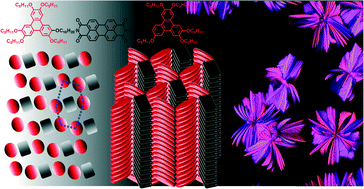Chemical engineering of donor–acceptor liquid crystalline dyads and triads for the controlled nanostructuration of organic semiconductors†
Abstract
Multi-segregated columnar structures provide a geometrically ideal scheme for ambipolar organic semiconductors, but are not easy to design. A set of novel materials with dyad and triad architectures based on 2 different discotic cores is reported and the conditions of emergence of such complex structures are investigated. The designed molecules associate together electron-donor triphenylene cores (D) and perylene or naphthalene diimides as acceptor moieties (A), both entities being linked via alkyl chain spacers. The evaluation in solution of their HOMO/LUMO energy levels by cyclic voltammetry demonstrates the preservation of the individual features of the D and A units. Their thermal and self-organization behaviors were studied by polarized-light optical microscopy, differential scanning calorimetry, temperature-dependent small-angle X-ray scattering and dilatometry, which permitted detailed investigation of the self-organization behaviour. These D–A compounds turned out to spontaneously self-organize into columnar mesophases at room temperature, with the D and A moieties segregated into either alternated stacks within mixed columns or in distinct columns, the latter providing an ideal configuration for 1D hole and electron transport pathways. In view of potential applications of the triad/dyad template, thin films of these self-organized materials were also probed by atomic force microscopy and grazing incidence X-ray scattering.



 Please wait while we load your content...
Please wait while we load your content...